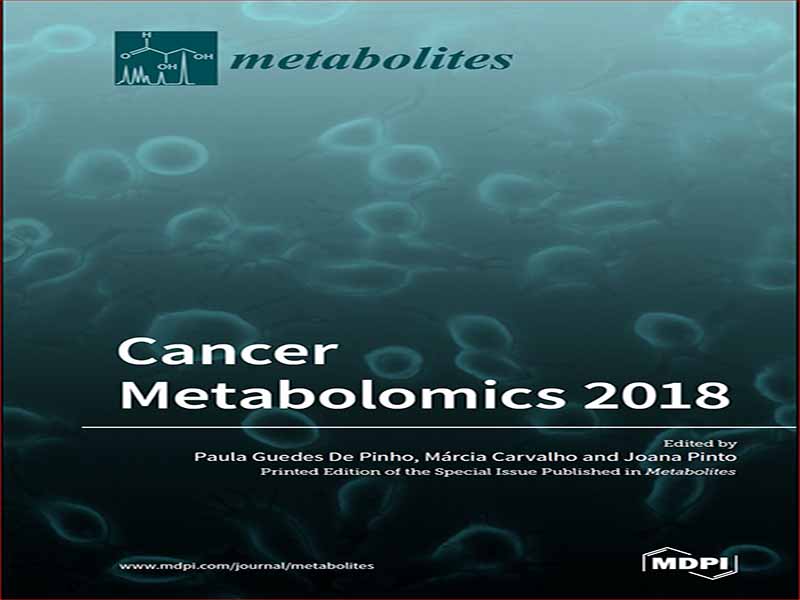- عنوان کتاب: Cancer Metabolomics 2018
- نویسنده: Paula Guedes De Pinho
- حوزه: سرطان
- سال انتشار: 2019
- تعداد صفحه: 186
- زبان اصلی: انگلیسی
- نوع فایل: pdf
- حجم فایل: 12.8 مگابایت
سرطان پروستات (PCa) دومین سرطانی است که اغلب تشخیص داده می شود و پنجمین علت مرگ و میر در مردان است [1]. در سال 2018، موارد جدید PCa بیش از 1.3 میلیون تخمین زده شد و 359.000 مرگ مرتبط با PCa در سراسر جهان پیش بینی شد [1]. PCa یک تومور وابسته به هورمون است که با یک دوره بالینی بسیار متغیر مشخص می شود، از یک وضعیت بی حال تا یک پیشرفت سریع به یک فنوتیپ تهاجمی که منتشر می شود و به غدد لنفاوی و استخوان ها متاستاز می دهد. علاوه بر این، در حال حاضر فقدان سنجش قابل اعتماد و قابل تکرار برای شناسایی تومورهایی که قرار است بیحال باقی بمانند وجود دارد. بنابراین، طبقه بندی بیماران PCa به فنوتیپ های خطر مختلف در زمان تشخیص هنوز یک چالش بالینی اصلی است. امروزه، تست های غربالگری PCa بر تعیین سطح سرمی آنتی ژن اختصاصی پروستات (PSA) و معاینه دیجیتال رکتوم (DRE) تکیه دارند. بر اساس نتایج این آزمایشات غربالگری، بیوپسی پروستات با هدایت اولتراسوند ترانس رکتوم (TRUS) برای تایید تشخیص در صورت لزوم انجام می شود. با این حال، این آزمایشها از تعدادی محدودیت رنج میبرند و اطلاعات کافی برای تمایز دقیق بین تومورهای ضعیف و تهاجمی ارائه نمیدهند. در حالی که PSA حساسیت بالا و ویژگی کم را برای تشخیص PCa فراهم می کند، بیوپسی پروستات هدایت شده (TRUS) به دلیل درجه بالای ناهمگنی بین و درون PCa با نرخ های منفی کاذب بالا همراه بوده است [2]. علاوه بر این، حتی تخمین مبتنی بر هیستوپاتولوژی که اخیراً به روز شده از امتیاز گلیسون (GS)، استاندارد طلایی بالینی فعلی برای ارزیابی خطر متاستاز و پیش آگهی PCa، محدودیت هایی را نشان می دهد [3]. در طول سالهای گذشته، بسیاری از مطالعات تحقیقاتی بر روی شناسایی بیومارکرهای مولکولی متمرکز شدهاند که میتوانند به بهبود تشخیص زودهنگام و طبقهبندی خطر بیماران PCa کمک کنند [4-7]. در میان آنها، یک نشانگر زیستی بالقوه، که در ترکیب با سطوح PSA ارزیابی شده است، رونوشت غیر کد کننده PCA3 است (بیش از حد در 95٪ از PCa بیان می شود). کمی سازی سطوح PCA3 در ادرار، هنگامی که با PSA ترکیب شود، در تشخیص PCa بهبود یافته است [8]، اگرچه هیچ قطع مطلوبی برای سطوح PCA3 ادراری برای به حداکثر رساندن مزایای بالینی و در عین حال اجتناب از تشخیص بیش از حد ایجاد نشده است [9]. یکی دیگر از نشانگرهای زیستی بالقوه، رونوشت همجوشی TMPRSS2:ERG [10] است که به عنوان یک هدف بالقوه تشخیصی و درمانی مرتبط با تهاجم PCa [11] ارزیابی می شود. علیرغم اینکه 100٪ نشان دهنده PCa [12] است، تنها در 50٪ موارد PCa شناسایی می شود [13]. به طور خلاصه، اگرچه تلاشهای زیادی برای کشف و توسعه بیومارکرهای جدید PCa انجام شده است، اما هنوز یک نیاز بالینی برآورده نشده برای شناسایی نشانگرهای زیستی دقیق PCa برای تشخیص زودهنگام، پیشآگهی و نظارت بر بیماران PCa، هم از نظر حساسیت و هم از نظر ویژگی وجود دارد. 14،15]. علاوه بر این، بیومارکرهای بالینی قوی دیگری که قادر به تمایز بین PCa ضعیف و تهاجمی هستند، به فوریت مورد نیاز هستند. در این زمینه، چندین مطالعه متابولومیک برای تلاش برای توصیف یک پروفایل متابولیک خاص PCa، با هدف نهایی شناسایی بیومارکرهای متابولیک بالقوه که میتوانند مدیریت بالینی بیماران PCa را بهبود بخشند، انجام شده است [16-19].
Prostate cancer (PCa) is the second most frequently diagnosed cancer and represents the fifth leading cause of death in men [1]. In 2018, new cases of PCa were estimated to account for over 1.3 million, and 359.000 PCa-associated deaths were expected worldwide [1]. PCa is a hormone-dependent tumor characterized by an extremely variable clinical course, ranging from an indolent condition to a rapid progression into an aggressive phenotype that disseminates and metastasizes to the lymph nodes and bones. Moreover, there is a current lack of reliable and reproducible assays to identify tumors destined to remain indolent. Thus, stratifying PCa patients into different risk phenotypes at time of diagnosis is still a major clinical challenge. Nowadays, PCa screening tests rely on the determination of prostate-specific antigen (PSA) serum levels and digital rectal examination (DRE). Based on the results of these screening tests, trans-rectal ultrasound (TRUS)-guided prostate biopsy is performed to confirm diagnosis when necessary. However, these tests suffer from a number of limitations and do not provide enough information to enable a precise discrimination between indolent and aggressive tumors. While PSA provides high sensitivity and low specificity for PCa diagnosis, (TRUS)-guided prostate biopsy has been associated with high false negative rates due to the high degree of PCa inter- and intra-heterogeneity [2]. Moreover, even the recently updated histopathology-based estimation of the Gleason Score (GS), the current clinical gold standard for assessing the risk of PCa metastasis and prognosis, exhibits limitations [3]. During the last years, many research studies have focused on the identification of molecular biomarkers that could help to improve early diagnosis and risk stratification of PCa patients [4–7]. Among them, a potential biomarker, that has been evaluated in combination with PSA levels, is the non-coding transcript PCA3 (overexpressed in >95% of PCa). The quantification of PCA3 levels in urine has shown improvement, when combined with PSA, in PCa detection [8], although no optimal cut-off for urinary PCA3 levels has been established for maximizing clinical benefit while avoiding overdiagnosis [9]. Another potential biomarker is the TMPRSS2:ERG fusion transcript [10], that is being evaluated as a potential diagnostic and therapeutic target associated with PCa invasion [11]. Despite being 100% indicative of PCa [12], it is only detected in 50% of PCa cases [13]. In summary, although intense efforts have been devoted to the discovery and development of new PCa biomarkers, there still exists an unmet clinical need to identify accurate PCa biomarkers for early diagnosis, prognosis and monitoring of PCa patients, both in terms of sensitivity and specificity [14,15]. Moreover, additional clinically robust biomarkers able to differentiate between indolent and aggressive PCa are urgently needed. In this context, several metabolomics studies have been carried out to attempt the characterization of a specific PCa metabolic profile, with the ultimate goal of identifying potential metabolic biomarkers that could improve the clinical management of PCa patients [16–19].
این کتاب را میتوانید بصورت رایگان از لینک زیر دانلود نمایید.
Download: Cancer Metabolomics 2018




































نظرات کاربران